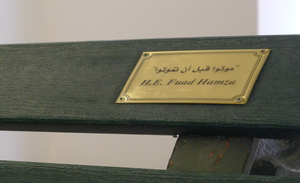Walid Sadek The Labour of Ruin
De erg
Révision datée du 18 juillet 2019 à 12:29 par Ergbot (discussion | contributions) (Page créée avec « {{Actualités |Subtitle=Vernissage : le 18 octobre 2013 à 18h00, galerie de l’erg |Start= |End= |Published=2013/10/17 |Image=Image 18png-1064-a66e5.png |Spipid=783 |Des... »)
| Actualités | |
|---|---|
| Publiée | 2013/10/17 |
Walid Sadek
The Labour of Ruin
Vernissage : le 18 octobre 2013 à 18h
50°49'19.50N 4°21'25.53E galerie de l'erg
Du 21 octobre au 14 novembre 2013 / Heures d'ouverture : mardi-vendredi, de 13 à 18h
For English version, scroll down
L'erg a le plaisir de vous convier à la conférence de Catherine Perret L'enseignement de la torture (en français), à l'occasion de la sortie de son livre du même titre au Seuil, La librairie du XXIe siècle et à la lecture The ruin to come de Walid Sadek (en anglais), qui aura lieu le 17 octobre à 19h au WIELS.
The Labour of Ruin est une exposition de l'artiste libanais Walid Sadek, qui réfléchit sur la relation entre la survivance et la production de ruines. Les travaux exposés, notamment For when Aeneas bears Anchises (2010), Would that a survivor (2013) et A belly of pardons (2013), proposent de repenser le fait de survivre hors de la temporalité du posthume.
"Quand pris comme une figure posthume, ou qui vit malgré sa mort, le survivant est un obstacle à la reconstruction de la société selon des directives normatives. Mais la persistance de la longue guerre civile au Liban appelle à une re-conceptualisation de la figure du survivant sur un autre axe temporel.
Non plus envisagé comme posthume, le survivant n'est pas un sur-vivant, mais plutôt un témoin qui en sait trop, et qui détient une connaissance indésirable mais nécessaire.
En dehors de leur retraite forcée, les survivants non-posthumes sont à la recherche du prochain endroit où se reposer, où la continuation du passé dans le présent peut encore trouver des moyens d’échapper à l'interdiction et ainsi commencer à construire la ruine nécessaire que seuls les survivants savent réunir. Cependant, la difficulté est de savoir si les prochains survivants peuvent construire un avenir vivable, et non simplement une période où ils seraient réintégrés de force dans les institutions sociales, ayant été préalablement étudiés, facilement classés dans l’Histoire."
Opening : October 18th, 2013 at 6 pm
From October 21st to November 14th , 2013
Opening hours : Tuesday-Friday, from 1 to 6 pm
erg invites you to the conference L'enseignement de la torture by Catherine Perret (in French), on the occasion of the publication of her homonymous book (by Seuil, La librairie du XXIe siècle), and to the lecture The ruin to come by Walid Sadek (in English), that will take place on October 17th at 7 pm at Wiels.
The Labour of Ruin is an exhibition by Lebanese artist Walid Sadek, which thinks the relation between surviving and the making of ruins. The exhibited works, including For when Aeneas bears Anchises (2010), Would that a survivor (2013) and A belly of pardons (2013), propose a rethinking of surviving outside the temporality of the posthumous.
"When framed as a posthumous figure, or that which lives on in spite of its death, the survivor is an impediment to the reconstruction of society along normative guidelines. But the persistent conditions of protracted civil-war in Lebanon call for a re-conceptualization of the figure of the survivor along another temporal axis.
No longer posthumous, the survivor is not an over-liver but rather a witness who knows too much carrying an unwelcome but necessary knowledge. Out of their forced retreat, the non-posthumous survivors search for where their next may lie ; where the continuance of the past in the present can still find byways to elude the gates of interdiction and thus begin to build the necessary ruin that only survivors know how to gather and make.
Yet the difficult question remains as to whether the next of survivors can amount to a livable future and not just a mere time to come during which they are forcibly reintegrated within social institutions, having been analyzed and given a place in chronology as a past event."
Born in 1966, Walid Sadek is an artist and writer. His early work investigates the violent legacies of the Lebanese civil war partially and inadequately experienced by a young Christian-born Lebanese : Home Play (1996) ; The Last Days of Summer (1997). He later began to posit, mostly in theoretical texts, ways of understanding the complexity of lingering civil strife in times of relative social and economic stability : A Matter of Words (2002) ; From Excavation to Dispersion : Configurations of Installation Art in Post-War Lebanon (2003) ; The Acquisition of Death : the Ends of Art and Dwelling in Lebanon (2004). His recent written work endeavors to structure a theory for a post-war society disinclined to resume normative living : From Image to Corpse (2006) ; Place at Last (2007) ; Seeing Rude and Erudite (2007) ; Peddling time when standing still, art remains and the globalization that was (2011) ; Collecting the Uncanny and the Labor of Missing (2012) ; In the Presence of the Corpse (2012). Concomitantly, a number of artworks propose a poetics for a sociality governed by the logic of a protracted civil war and search for a critical temporality to challenge that same protractedness : Love is Blind (2006) ; Dear Stephen (2006) ; Knowledge of the Expelled (2007) ; Mourning in the Presence of the Corpse (2007) ; On Learning to See Less (2009) ; Place at Last (2010) ; Kozo Okamoto resides in Greater Beirut (2010) ; The Labor of Missing (2011) ; The Wreck of Hope and the Other Side of Impatience (2012) ; Beirut Open City (2013).
Contact :
Michela Alessandrini
Curator in residence
+32 (0) 485563124
michela.alessandrini@erg.be
50°49'19.50N 4°21'25.53E
galerie de l'erg
Rue du Page, 87
1050 Bruxelles
www.erg.be
